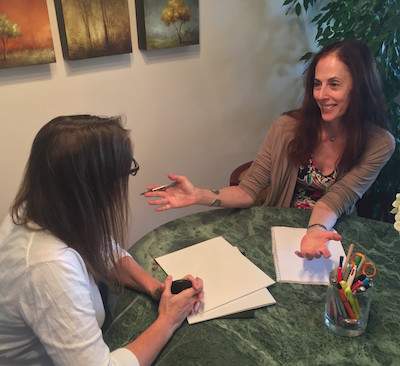Sarah was being a good sport but the extra hour delay pushed her too far. Fortunately, we made up some of the delay in the air, and our guide was still waiting for us when we landed. By 9:30am Sarah had mixed and gulped down her strawberry smoothie in a van en route to Ephesus. Before reaching Ephesus, our guide, Pinar, suggested we stop to see the house where the Virgin Mary supposedly spent her last years.
Pinar answered Max in a tentative fashion, but she seemed pained—rather than charmed—by my son’s eager questioning. Both Pinar’s English and her personality were weaker than we had hoped. We were also disappointed in Mary’s last home, a sad little claustrophobic room where some people were moved to pray and light candles.
Ephesus was another story. One of the best preserved cities in history, Ephesus lived up to its reputation as a “Wonder of the World.” Instead of piles of rubble or massive restoration, we could see the basic structure of the ancient city. There were ingenious toilets (for the men only, of course) still intact. Built thousands of years ago, these stone benches with holes were constructed on the side of the mountain so that waste could be “flushed” away by rain. The toilet holes were close together, and there was no privacy. But I’m guessing these primitive facilities were better than whatever arrangements (or lack thereof) existed for women of the 1stcentury A.D.
A whole wall of the original library was also still standing, a sight so awesome we were inspired to ask Pinar take a family picture. Pinar proved to be a better photographer than a guide, and she probably snapped this year’s holiday card that day in front of the Ephesus library wall. The photo makes a great Jeopardy question. Under the category, “Famous Ruins,” it might read: “The Elisofon family stands before the walls of this ancient library.” Friends who remember our holiday card picturing our family in front of the Roman coliseum may find themselves stumped this year.
After exploring Ephesus— and trying to learn more about it by eavesdropping on other English speaking guides— we stopped for lunch. Pinar had arranged a local smorgasbord of salad, kebobs, and a Turkish version of a mini-pizza. For the record, Pinar won first prize for best photographer, best lunch provider, and worst guide.
Before returning to the airport, Pinar took us to another carpet store, in spite of the fact that Henry warned her that we’d already done the magic carpet ride with another guide the day before and hadn’t bought anything.
“This one will be different,” Pinar promised. “Here they will show you how they make rugs from silk worms. You didn’t see that yet?”
“No, we didn’t.” Henry sighed.
“And here they weave the highest quality silk rugs. These are signed pieces made only by one family. Works of art.”
We sat through another rug presentation, complete with the same apple-flavored, hot tea we’d sipped the day before. As Pinar had promised, this spiel included showing us silk worms. The proprietor even insisted I hold one—a dry oval shaped ball—and unravel a thread, which I did reluctantly, not wanting to expose the worm inside. Then it was time to sit down to see the “works of art.” These were signed by the family, and were much more densely knotted and expensive than the ordinary silk rugs, already pricey at several thousand dollars apiece
Our last stop with Pinar was a ceramic store. We almost bought a salad bowl, but the merchant couldn’t ship it, and I didn’t want it enough to schlep it on three airplanes, especially after learning it couldn’t go in the dishwasher once I got home. No commission for Pinar, I’m afraid.
Exhausted, we flew back to Istanbul and then onto Athens and Mykonos, where we rested for six days at the beach. Here we lounged in the shade and swam in the cool, clear waters of the Aegean. Max and Henry bonded during power walks while Sarah and I sweated in the gym. At night we drove into the town of Mykonos on crowded, narrow roads filled with tour buses, motorcycles, ATVs and cars of all sizes, navigating crazy intersections. Walking from the parking lot to the restaurants was an adventure. Pedestrians did NOT have the right of way, but somehow the Elisofon family walked single file and survived the perilous treks to and from dinner.
Mykonos was a fascinating melting pot of tourists from all over the globe. There were couples, families, and groups of gay men all conversing in different languages. Even our hotel was a mix of elegantly attired families and young couples with tattoos and body piercings. Henry noted that nearly everyone on the beach, regardless of age, was thin. Could it be that the Mediterranean diet really worked?
Our last stop was Athens—a final two day blitzkrieg of sight-seeing. The first day we saw Corinth, Mycenae, Nafplio and Epidaurus. The Corinth Canal was an impressive engineering feat for its time–a ribbon of blue blasted through mountainous rock, but so narrow that it’s hardly used anymore. While the view was spectacular, Max has agoraphobia so we didn’t linger. At Mycenae (1600-1100 BC), we entered through the original gates carved with lions and saw the beehive tombs. Lunch was in the seaside town of Nafplio, and then family Elisofon ended up in Epidaurus where the original theatre (4000 BC) seats 15,000. This amphitheater has such great acoustics that concerts are still held there.
Our last day was spent speeding through the Acropolis, the Parthenon and the Acropolis Museum. We enjoyed these sights, but the most interesting part of our day turned out to be the political discussion between Angelos, our tour guide, and George, the driver.
On the first day of our Athens tour, Max had asked our guide, Angelos, about the political situation in Greece.
“I’m not supposed to discuss politics.” Angelos answered. “Everything here is okay,” he added in a tone which implied the opposite.
“Oh, come on, we know you want to talk about it,” Max challenged him. “Every cab driver has been complaining about the European Union. One guy insisted Greece would be better off going back to the drachma.”
“Let’s talk about these aqueducts on your left instead….”
But my son can be very tenacious and eventually wore down our driver as well our guide on the second day. “Can you explain the rise in the Neo-Nazi party here?” He asked on the way back to the hotel.
“It’s because the Nazis are helping the poor and helpless.” George, the driver, finally explained. Our driver had barely uttered a word for two days, and yet he suddenly revealed himself to be an educated, articulate man who spoke excellent English. He confided in us that he’d become a driver after losing his record business. “Old people will vote for Nazis if they offer them a ride to the supermarket.” He shook his head. “They don’t understand.”
“Well, that’s partly true, but it’s not as simple as that….” Angelos, our guide, added.
We talked and laughed all the way back to our hotel; after two days of touring, we had finally become friends. Both the driver and the guide trusted us not to report them to their travel company. Before saying goodbye, we exchanged business cards, and I even promised to email a link to this blog
Our Ottoman Odyssey turned out to be a total success. The ever-complicated Elisofon family had gotten along well, and no one had gotten sick. We had seen historic places, snapped great photos, and hopefully created lasting memories. Miraculously, we’d made our plane connections; our luggage hadn’t been lost or stolen, and Sarah had stayed on her diet without having her powders confiscated or shutting down the airport.




 Marguerite Elisofon is a New York City writer and the author of My Picture Perfect Family, a memoir about how her family navigated life with a child on the autistic spectrum before the internet and support groups existed. She also blogs about parenting young adults and disability related issues in The Never Empty Nest. Her writing has been featured in a variety of publications, including Time and NY Metro Parents magazine, and her family’s story has been featured by the NY Post, Fox News, The Daily Mail, and on Jenny McCarthy’s Dirty Sexy Funny radio show. A Vassar graduate, Marguerite was born and raised in New York City, where she still lives with her husband, Howard, in their mostly-empty nest. She is available to speak about a wide variety of issues relating to twins, parenting, and autism.
Marguerite Elisofon is a New York City writer and the author of My Picture Perfect Family, a memoir about how her family navigated life with a child on the autistic spectrum before the internet and support groups existed. She also blogs about parenting young adults and disability related issues in The Never Empty Nest. Her writing has been featured in a variety of publications, including Time and NY Metro Parents magazine, and her family’s story has been featured by the NY Post, Fox News, The Daily Mail, and on Jenny McCarthy’s Dirty Sexy Funny radio show. A Vassar graduate, Marguerite was born and raised in New York City, where she still lives with her husband, Howard, in their mostly-empty nest. She is available to speak about a wide variety of issues relating to twins, parenting, and autism. 